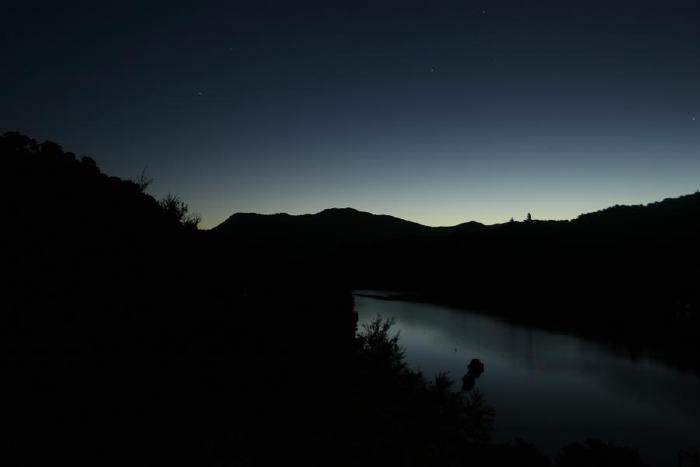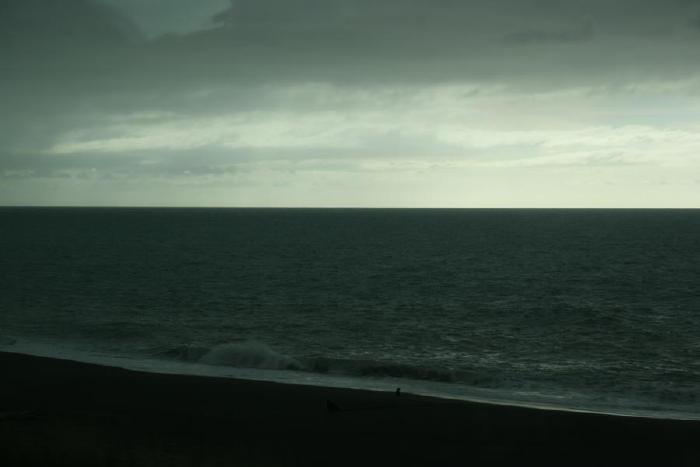Wickets
southpole .....
Monday morning and Jan, Timo and I are on the Northbound train from Christchurch to Picton. Outside, greens and browns of grasses, dry scrub, and trees blur together with grey skies, rain and the dun coats of sheep. It always seems to rain during my train trips here. It’s hard to believe that just Friday morning we were at the South Pole.
Thursday night, having Bag Dragged and then sweated in the sauna ('Epic’ was how colleague Stephanie described that last, crowded, lengthy steam-bath — with multiple trips outside to Destination Zulu to photograph the steam rising off our bodies, trips which were surprisingly pleasant despite the 260 degree Fahrenheit temperature transitions involved), the younger crowd stayed up partying all night, while comparatively 'old’ folks like myself turned in for a few hours of sleep. Friday 'dawned’ (not a word which applies literally at South Pole for more than one long week per year) abruptly, with the announcement of the early off-deck of our plane from McMurdo… an announcement which I missed somehow, but caught on the online 'scroll.’ Given that the flight was going to arrive, and therefore leave, early, I spent a few minutes tracking everyone down so that nobody would miss the flight.

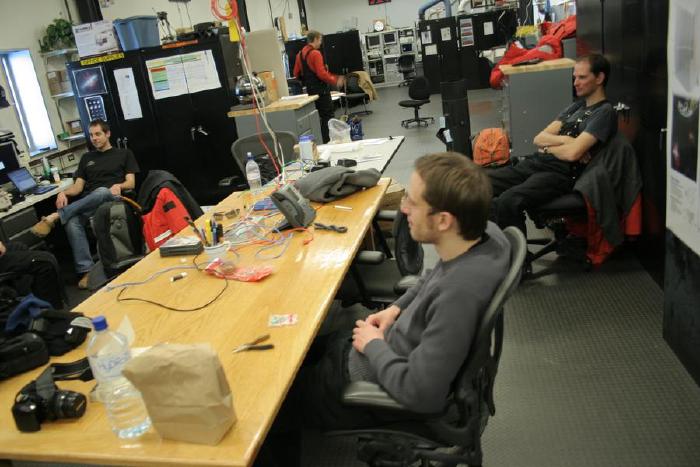
The last few summer flights from Pole are somewhat bittersweet for all concerned. The winter folks are glad to have the Station to themselves at last, but of course it marks the beginning of eight and a half months of isolation. The Summer crew eagerly await oxygen, moisture, 'freshies,’ night, family, vacation and sleep. But many of us will never return to the Pole.


Winter-overs Camille and Erik came out to say goodbye to the last ten or so of us 'Cubers to leave. The flight came and we huddled around in the -50F air like a bunch of penguins until we were signaled to approach the plane. Awash in the deafening roar of the props near the nose of the aircraft, I turned and waved to Erik and saw his wave in response. Then it was climb the stairway, stuff myself and my bags into the nearest available seat, and buckle in. There actually weren’t enough seats for the available passengers, so Stephanie, who got on last, was pulled aside and got to experience take-off from South Pole with the flight crew in the cockpit. After takeoff the pilots pressurized the cabin to more atmospheres than I’d had since Jan. 20.

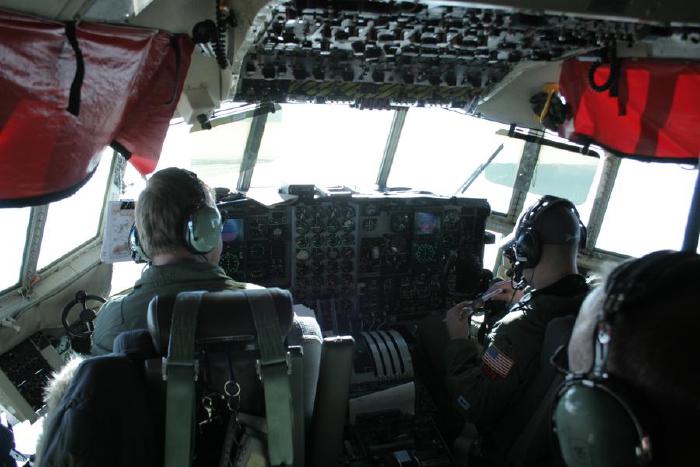
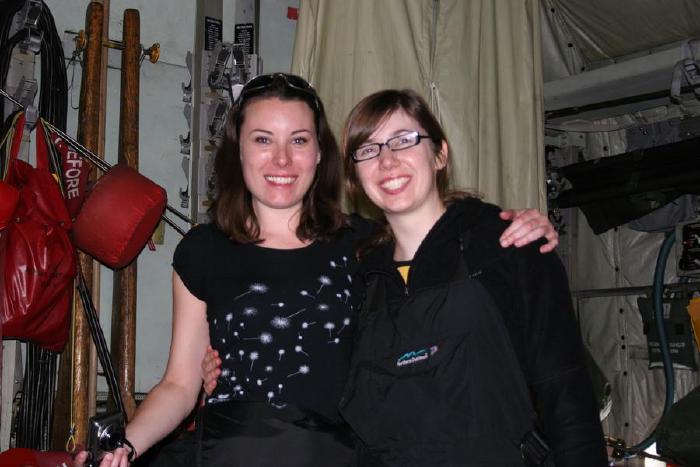
We arrived at the Pegasus ice runway to overcast weather, with Castle Rock and Ob. Hill barely visible, Mt. Erebus not at all. The Herc disgorged us and our bags and immediately took to the air again to land at Williams field, a mere handful of miles away. We had our choice of rattling around on the ice outside (the weather was certainly warmer than Pole, with Real Snow™ but rather windy) or the 'pax terminal,’ a grungy orange box on skis, big enough to hold fifty or so people. After taking the obligatory photos of the various firefighting vehicles nearby, we packed inside and settled in for the two hour wait for the C-17 from Christchurch.
We debated whether we could feel the difference in the altitude. Stephanie was the only one who said she felt nothing at all. I could, as usual: I find the sensation of returning to sea level to be a vertiginous cross between a caffeine dose, a feeling of having come in from the rain and changed clothes, and, paradoxically, being so relaxed I feel like taking a nap (though that last part could have more to do with shifting from night shift to days in less than 48 hours).
To kill time we set up my laptop and fired up The Incredibles (with subtitles, because of the noise of other people talking), the audience eventually expanding to include a couple of non-Cubers. The C-17 arrived just after Helen and the kids were shot down in their aircraft and 'paddled’ to shore. The plane’s arrival meant we all felt we had to suit up and watch the unloading and loading of cargo despite the fact that it clearly would be a full hour before we were waved onto the plane.
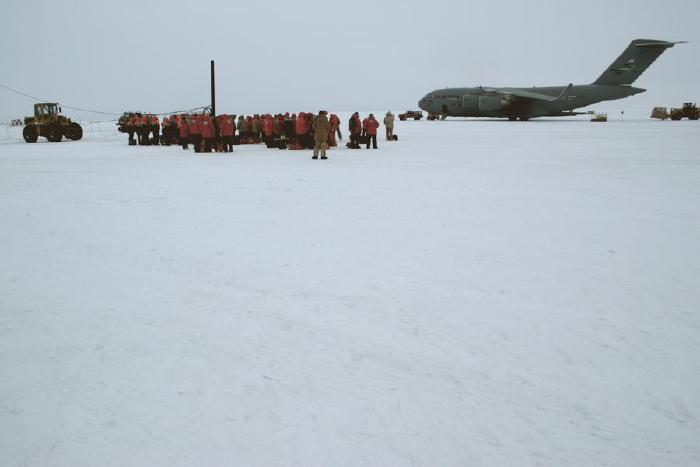
At some point each of us started to remember that it doesn’t have to be -50F to feel extremely cold (it was probably about 20F but much more humid than at Pole). But soon enough we were packing into the C-17. Just before I entered the plane, I turned around and took what may have been my last look at Antarctica: a panorama of whites and subtle, pale grays… a few distant mountains shrouded by low-hanging clouds, outcroppings of rock, and a handful of human artifacts out on the airfield. Not much to look at, but special somehow in some way I have never quite been able to articulate.
One’s first look at Antarctica is thrilling: here you are in a place most people will never see except in pictures or on film or TV. It is an otherworldly place whose few native inhabitants, while familiar through media and popular culture, are quite alien up close. (Penguins, for example, are somehow much odder 'in the flesh’ than one would expect). The people, too, tend to be a breed apart somehow. Many of them young, most of them white and lower to middle class, they come from all over the world but often hail from the US Midwest or mountain states; are often better educated than their on-Ice job descriptions would suggest; and have robust senses of humor and very tight social ties with one another. 'Repeat offenders’ such as myself tend to be both specialists who have niched themselves so tightly into their work that they are hard to replace, and people who cherish the sense of community that exists on the Ice. In addition to the colleagues you know and don’t get to see except on the Ice, it is somehow reassuring to see all those other familiar faces season after season, even when you don’t know their names. One feels like one is part of something, though it is hard to say what that something is. Surely, we are there to do or to support science… but there are geopolitical angles as well, a fact which adds a slight tinge of artificiality to the whole enterprise. And then there is the fact that one reason we are there is … because it is there. Antarctica is a mountain to be climbed, a planet to visit, a river to cross.
In November, an expeditioner named Todd Carmichael set off from a coastal location called Hercules Inlet and broke the world’s speed record for unassisted traverse to the Pole. His ski bindings broke soon after beginning his trip, so he proceeded the rest of the way on foot. By the time he reached the Pole he was so disoriented that he talked to his sled and had trouble finding the station even when it was right in front of him. A colleague interviewed him on video while he was recovering in the medical clinic at the Pole. At the other end of what had turned out to be a near-death experience, Carmichael talked about endurance not just as a means to reach a goal but as a value in itself. “Hard things are good for you too.” That value resonates for me, and I suspect it does as well for other travellers to the Ice.
Sometimes, after sweating through my daily session in the station’s gym, I’d step directly outside into the cold air on the upper level deck outside the Station. With nothing on but running shoes, shorts and a t-shirt, someone who is warmed up can last up to a minute or two outside without even getting particularly cold. It’s enough time to reestablish the sense of where you are: the incredible brightness; the view of the experimental buildings in the Dark Sector; the crossing beacon for the skiway; a thousand half-buried flags indicating buried cables, buildings, fuel lines; the view, off to one’s left, of Summer Camp and the cargo berms. The cold so sharp it makes your lungs ache to take a deep breath. A momentary flash of the South Pole, of the diamond-crisp beauty of the place, the infinitely flat wisps of clouds on the rim of the sky at the very edge of the world. No longer novel, Antarctica, but personal, and deadly, and dear.
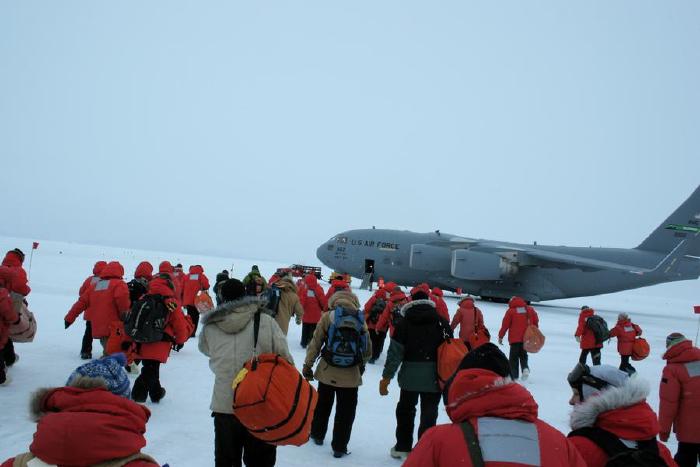
The C-17 flight back to New Zealand seemed short thanks to my having slept, sitting up, through most of it… waking often, sore, desperately wishing for a bed, and then falling unconscious again. By the time I woke completely we were readying for our descent into Christchurch. People stripped out of their gear and emerged as individuals, with long hair, piercings, tattoos, shorts, sandals. You have to go through customs again before they’ll let you back into New Zealand. The customs officials ask, “Did you fly to the Ice from Christchurch?” Not being Todd Carmichael, the answer, of course, is always yes. Night time, humidity, wait for a shuttle, then back at the Devon, were the beckoning of the bed trumps even that first, long shower.
The weekend was spent shopping for gifts from home, delighting in real food (bananas, beer, fish, salads, Banoffee Pie from the Dux again!) and, Sunday, watching a four hour cricket match at a park on the outskirts of town. Stephanie and Suruj, both colleagues from Canterbury University in Christchurch, were there to teach the rules and the finer points of strategy and culture (trivia question: Who played the first international cricket game? Answer: the United States vs. Canada). I would always rather watch a sporting match in person than on TV, and would rather play than watch. Suruj presciently obliged by bringing a cricket bat and ball: at half time we took to the field with about a thousand underage Kiwis and he taught us how to bowl and to bat.
Now it is Tuesday and I am perched in the top floor of a house looking out over the Queen Charlotte Sound, about twenty minutes by boat from Picton. My gracious hosts at the Fern Ridge Homestay are Nicki and Neil. I spent the morning walking a four-hour portion of the Queen Charlotte Track, similar to what I did last year. Nicki took me by boat to Torea Bay and picked me up at Mistletoe Bay. As I walked along the Track, cicadas as large as small hummingbirds thudded against my hat, their collective cries throughout the bush loud enough to drown out a C-130. I also passed a six hundred year old rimu tree, a specimen of the kind that used to cover much of New Zealand, a tree similar in size, age and kind to the redwoods of California. On our way back, after picking me up, Nicki stopped the boat in a small harbor along the way to feed breadcrumbs to the herring and mackerel, which swarmed so thick to the food that I could feel their slimy, wriggling bodies as I swept my hand through the water.
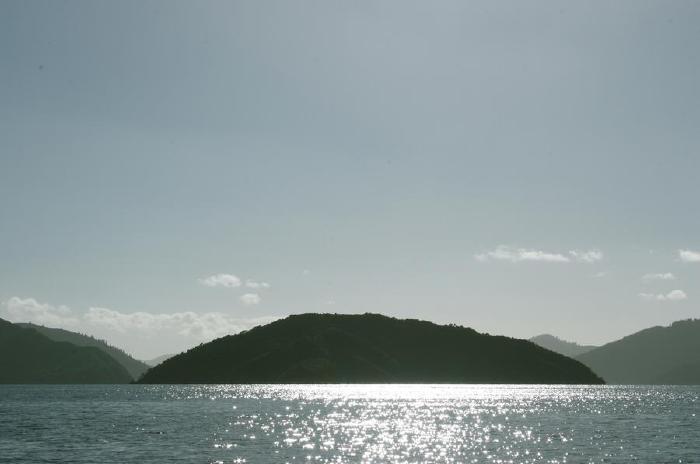
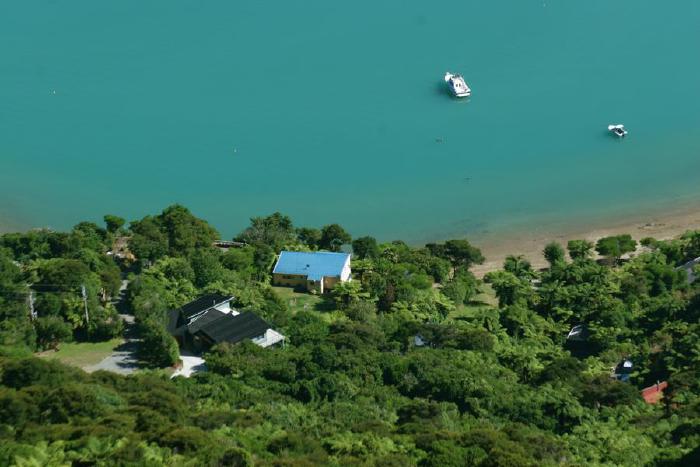

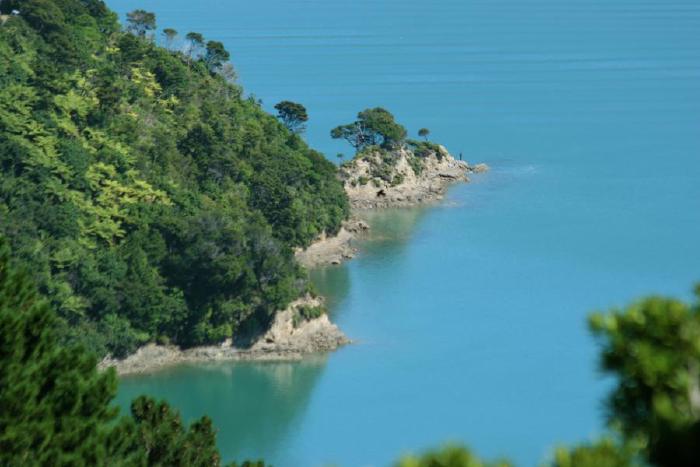
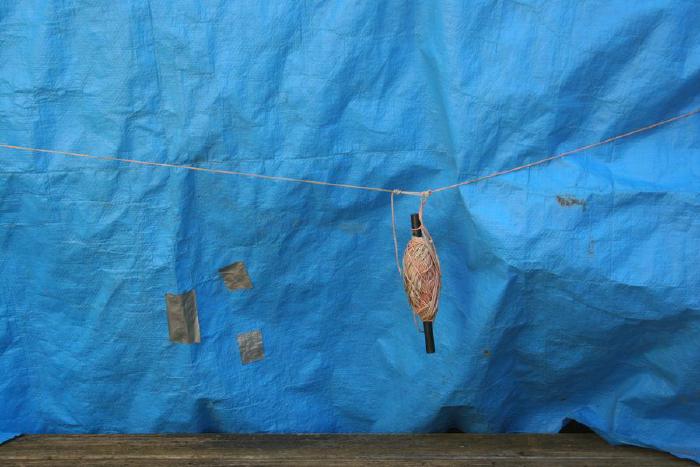
I have another night here and another day on the Sounds; then a night in Picton, after which I take the ferry to Wellington to see Neil and Amelia. The it’s back to winter in Chicago, which will hopefully be almost over. I am looking forward to seeing Eden, family, friends, to being in my studio, and to being in one place again for awhile.
